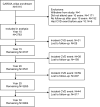Longitudinal Associations of Smoke-Free Policies and Incident Cardiovascular Disease: CARDIA Study
- PMID: 29735485
- PMCID: PMC6202173
- DOI: 10.1161/CIRCULATIONAHA.117.032302
Longitudinal Associations of Smoke-Free Policies and Incident Cardiovascular Disease: CARDIA Study
Abstract
Background: Smoke-free legislation has been associated with lower rates of cardiovascular disease hospital admissions in ecological studies. However, prior studies lacked detailed information on individual-level factors (eg, sociodemographic and clinical characteristics) that could potentially confound associations. Our objective was to estimate associations of smoke-free policies with incident cardiovascular disease in a longitudinal cohort after controlling for sociodemographics, cardiovascular disease risk factors, and policy covariates.
Methods: Longitudinal data from 3783 black and white adults in the CARDIA study (Coronary Artery Risk Development in Young Adults; 1995-2015) were linked to state, county, and local 100% smoke-free policies in bars, restaurants, and nonhospitality workplaces by Census tract. Extended Cox regression estimated hazard ratios (HRs) of incident cardiovascular disease associated with time-dependent smoke-free policy exposures. Models were adjusted for sociodemographic characteristics, cardiovascular disease risk factors, state cigarette tax, participant-reported presence of a smoking ban at their workplace, field center, and metropolitan statistical area poverty.
Results: During a median follow-up of 20 years (68 332 total person-years), 172 participants had an incident cardiovascular disease event (2.5 per 1000 person-years). Over the follow-up period, 80% of participants lived in areas with smoke-free policies in restaurants, 67% in bars, and 65% in nonhospitality workplaces. In fully adjusted models, participants living in an area with a restaurant, bar, or workplace smoke-free policy had a lower risk of incident cardiovascular disease compared with those in areas without smoke-free policies (HR, 0.75, 95% confidence interval, 0.49-1.15; HR, 0.76, 95% confidence interval, 0.47-1.24; HR, 0.54, 95% confidence interval, 0.34-0.86, respectively; HR, 0.58, 95% confidence interval, 0.33-1.00 for living in an area with all 3 types of policies compared with none). The estimated preventive fraction was 25% for restaurant policies, 24% for bar policies, and 46% for workplace policies.
Conclusions: Consistent with prior ecological studies, these individual-based data add to the evidence that 100% smoke-free policies are associated with lower risk of cardiovascular disease among middle-aged adults.
Keywords: cardiovascular diseases; epidemiology; health policy; risk factors; smoking.
Figures


Comment in
-
Smoke-Free Policies: No Time to Waste.Circulation. 2018 Aug 7;138(6):567-569. doi: 10.1161/CIRCULATIONAHA.118.035337. Circulation. 2018. PMID: 30354624 No abstract available.
References
-
- U.S. Department of Health and Human Services. A Report of the Surgeon General. Atlanta, GA: 2014. The Health Consequences of Smoking – 50 Years of Progress.
-
- Luoto R, Uutela A, Puska P. Occasional smoking increases total and cardiovascular mortality among men. Nicotine Tob Res. 2000;2:133–139. - PubMed
-
- Pope CA, 3rd, Burnett RT, Krewski D, Jerrett M, Shi Y, Calle EE, Thun MJ. Cardiovascular mortality and exposure to airborne fine particulate matter and cigarette smoke: shape of the exposure-response relationship. Circulation. 2009;120:941–948. - PubMed
Publication types
MeSH terms
Grants and funding
LinkOut - more resources
Full Text Sources
Other Literature Sources
Medical

